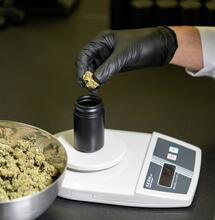Using Epsom Salts in Your Organic Cannabis Garden

Epsom salts are a natural, inexpensive and environmentally-friendly supplement for your organic Cannabis crop.
Epsom salts (also known as hydrated magnesium sulfate, MgSO4 + 7H2O) have been used for centuries to treat human ailments, as well as providing a reliable, traditional tool for gardeners experiencing magnesium deficiencies. The salts were discovered imbuing the spring waters of Epsom, England, and are often used by gardeners as a folk-wisdom plant remedy.
As Cannabis is indeed a plant, and plants require nutrients, one common scourge of growers is the constant necessity of purchasing, using and dispensing of gallons of nutrient solutions. Various macro- and micro-nutrients can be provided in a myriad of forms; however, these days, much more emphasis is being placed upon keeping Cannabis gardens as organic as possible. Well-maintained, clean, organic grow rooms and gardens tend to produce the best-tasting, highest quality buds, which are also safer for medical patients to consume.
Epsom salts provide both magnesium (Mg) and sulfate (SO4, an ester or salt of sulfuric acid) in a gentle form that is easy for Cannabis plants to process - one that does not build up in soil over time. This home remedy is also simple to use, inexpensive and a highly-soluble supplement for organic Cannabis growers. However, Epsom salts are usually only applied to plants that are visibly lacking in magnesium, or strains that are typically magnesium-deficient.
Why do Cannabis plants need magnesium?
Magnesium allows plants to uptake phosphorous (P), nitrogen (N) and sulfur (S) from soil. Plants that are deficient tend to show yellowing leaves, which may remain green at the leaf veins. Magnesium deficiencies cause a different yellowing effect than nitrogen shortages or spider mite damage; be certain to correctly diagnose excesses and deficiencies in your plants before adjusting your nutrients, or you may burn the plants while worsening whatever deficiency ails them.
Yellowing leaves with green veins may be a sign that your plants are magnesium-deficient.
Magnesium facilitates the creation of chlorophyll and is thus critical for photosynthesis. The element also strengthens cell walls, assisting the plant in maintaining its structure and vitality. If you notice slow growth, a slight curling of the leaves and a yellowing of the leaf color (typically beginning towards the bottom of the plant), there is a good chance that your plants are magnesium-deficient. These plant symptoms are often referred to within the growing community as 'praying for magnesium'. Begin with small doses to test the results, which you should see in about four days.
Concerning Cannabis flowers - and potentially seeds - magnesium is essential to a healthy yield. Those growing either for or from seed should note that magnesium also plays a vital role in both seed production and germination.
Why is sulfur necessary for weed plants?
In combination with magnesium, sulfur forms a sort of 'multi-vitamin' for plants, allowing for increased uptake and impact of nutrients and minerals, and acting as a general prophylactic for your plants. Sulfur binds with the soil to increase the availability of nitrogen (N), phosphorous (P) and potassium (K) to the plant's roots, thus enhancing the capability of soil and added nutrients. The plant's production of amino acids, enzymes and vitamins are all affected by sulfur levels, making the element essential to plant growth and development.
Rarely deficient in most modern Cannabis nutrients, sulfur also assists in chlorophyll production, helping gardeners to keep their plants green, vibrant and healthy. This and the aforementioned benefits are especially important for long-life plants, such as mothers or outdoor strains with a slow finish, as sulfur helps to sustain longevity and over-all plant health while protecting against environmental stress.
Technical growers should note that reverse-osmosis (RO), ion exchange or distilled watering systems will effectively remove most sulfate from drinking water, which can easily be replaced with Epsom salts, if necessary. (Growers in areas known for 'hard' water will often give their plants extra magnesium.)
How to Use Epsom Salts to Supplement Soil:
Whether growing in pots or beds, Epsom salts are an effective way to supplement your soil before you have even begun growing any plants; that is, if you are not already using dolomite lime as a magnesium source. Soil that measures a pH above '7' - or one that is high in potassium (K) and/or calcium (Ca), which compete with magnesium for uptake by the plant - can be replenished via applications of the salts. Such soil may not react as well to a direct granular or dissolved application; plants grown in this soil tend to respond much better to a foliar spray or full watering with Epsom salts.
Large-scale outdoor growers in the Pacific Northwest (and gardeners in the Southeast) often struggle with depleted local soil that must be turned and treated before cuttings or seeds can be planted. Prepare your substrate by mixing in one teaspoon of salts per gallon of soil, then planting seeds, seedlings or clones - magnesium sulfate can account for faster germination. If you prefer, you can wait until your seedlings are a few inches tall, then water them all with a highly-diluted Epsom salt solution. Cuttings - which can be notoriously difficult to root in their new environment, depending upon strain and clone health - may potentially take hold more quickly and experience less shock as a result of this soil treatment.
Epsom salts provide both magnesium and sulfur to deficient Cannabis plants.
Dosage for Dissolving Epsom Salts in Water:
Smaller-scale and indoor growers benefit more readily and consistently from dissolving the salts into water rather than soil. In a watering can or barrel, combine up to two tablespoons per gallon of water - first mixing the salts with a bit of warm water to thoroughly dissolve them. This can be given to the plants every four to six weeks, if necessary.
To apply a foliar spray, dissolve up to one tablespoon per gallon of water and spray Cannabis plants at the beginning of each cycle or when needed, focusing the majority of the fine mist upon the underside of the leaves. Avoid spraying your plants past the first few weeks of flowering, or while the lights are on; if you must spray them during the 'daylight' cycle, allow the plant to cool down before and after - and dry off - before turning the lamps back on. It is more effective, however, to spray the plants when both they and the room are cooler in temperature.
Epsom Salts to Revive Mothers or Root-Bound Plants:
When plants remain for too long in the same pot, they can suffer from salt buildup and become nutrient-locked and/or pot-bound. An easy and gentle Epsom salt solution will dissolve the accumulated salts and allow the plant to regain healthy circulation by unclogging its root cells. This is especially effective in plants that require direct sunlight - a category in which Cannabis is firmly listed - due to the importance of magnesium sulfate in photosynthesis.



